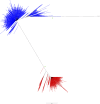JN.1 variants circulating in Italy from October 2023 to April 2024: genetic diversity and immune recognition
- PMID: 40022017
- PMCID: PMC11871800
- DOI: 10.1186/s12879-025-10685-0
JN.1 variants circulating in Italy from October 2023 to April 2024: genetic diversity and immune recognition
Abstract
Background: The continuous emergence of SARS-CoV-2 variants and subvariants poses significant public health challenges. The latest designated subvariant JN.1, with all its descendants, shows more than 30 mutations in the spike gene. JN.1 has raised concerns due to its genomic diversity and its potential to enhance transmissibility and immune evasion. This study aims to analyse the molecular characteristics of JN.1-related lineages (JN.1*) identified in Italy from October 2023 to April 2024 and to evaluate the neutralization activity against JN.1 of a subsample of sera from individuals vaccinated with XBB.1.5 mRNA.
Methods: The genomic diversity of the spike gene of 794 JN.1* strain was evaluated and phylogenetic analysis was conducted to compare the distance to XBB.1.5. Moreover, serum neutralization assays were performed on a subsample of 19 healthcare workers (HCWs) vaccinated with the monovalent XBB.1.5 mRNA booster to assess neutralizing capacity against JN.1.
Results: Sequence analysis displayed high spike variability between JN.1* and phylogenetic investigation confirmed a substantial differentiation between JN.1* and XBB.1.5 spike regions with 29 shared mutations, of which 17 were located within the RBD region. Pre-booster neutralization activity against JN.1 was observed in 42% of HCWs sera, increasing significantly post-booster, with all HCWs showing neutralization capacity three months after vaccination. A significant correlation was found between anti-trimeric Spike IgG levels and neutralizing titers against JN.1.
Conclusions: The study highlights the variability of JN.1* in Italy. Results on a subsample of sera from HCWs vaccinated with XBB.1.5 mRNA booster vaccine suggested enhanced neutralization activity against JN.1.
Keywords: Genomic surveillance; JN.1; Neutralizing antibodies; Phylogenetic analysis; SARS-CoV-2.
© 2025. The Author(s).
Conflict of interest statement
Declarations. Ethics approval and consent to participate: Informed consent was obtained from all the enrolled participants to collect sera for neutralization assay. The study was approved by the Italian National Ethics Committee for clinical trials of public research bodies and other national public institutions (CEN) at the Istituto Superiore di Sanità (ISS), (AOO-ISS 10/10/2023 0045874). Molecular investigation was conducted as part of the Italian SARS-CoV-2 virus variants monitoring. Consent for publication: Not applicable. Competing interests: The authors declare no competing interests.
Figures




References
-
- Ulrichs T, Rolland M, Wu J, Nunes MC, El Guerche-Séblain C, Chit A. Changing epidemiology of COVID-19: potential future impact on vaccines and vaccination strategies. Expert Rev Vaccines. 2024;23:510–22. - PubMed
-
- Kaku Y, Okumura K, Padilla-Blanco M, Kosugi Y, Uriu K, Hinay AA, et al. Virological characteristics of the SARS-CoV-2 JN.1 variant. Lancet Infect Dis. 2024;24:e82. - PubMed
MeSH terms
Substances
Supplementary concepts
LinkOut - more resources
Full Text Sources
Medical
Miscellaneous

